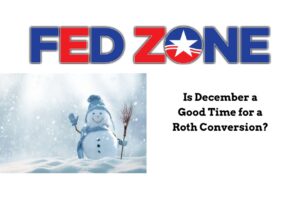December May Be a Good Time to Perform a Roth IRA Conversion Under Certain Conditions
Edward A. Zurndorfer

Federal employees have until April 15, 2021 to make their 2020 Roth IRA contributions. However, those employees whose adjusted gross income (AGI) is large and above specified limits are not allowed to contribute to a Roth IRA. In particular, for 2020 those employees who file their income tax returns as married filing joint and whose AGI exceed $206,000 are not permitted to contribute to a Roth IRA. Employees who file as single or head of household and whose AGI exceeds $139,000 during 2020 are not permitted to contribute to a Roth IRA.
However, one option available to any individual – no matter the individual’s age, working status, or marital status is to convert an existing traditional IRA to a Roth IRA. This column discusses the conversion of a traditional IRA to a Roth IRA, and why the current month of December is for some federal employees may be an ideal time to perform a Roth IRA conversion. Also presented are some of the pitfalls of Roth IRA conversions and what potential Roth IRA converters need to be aware of – before they convert.
The following are the recommended steps to be followed in a Roth IRA conversion:
Step 1. If an employed individual does not own a traditional IRA, then the individual must open one and fund it. The recommended type of traditional IRA to open is a nondeductible traditional IRA in which the contributions are made with after-taxed dollars. This is because: (1) anyone with earned income can contribute to a nondeductible traditional IRA. There are no AGI or age limitations for contributing to a nondeductible traditional IRA; and (2) assuming that the IRA owner reports the contributions on IRS Form 8606 (Nondeductible IRAs) as a nondeductible contribution. IRS Form 8606 is filed with the IRA owner’s federal income tax in the year that the nondeductible IRA contribution is made. If a nondeductible IRA contribution is made in December 2020, then Form 8606 is included with the IRA owner’s 2020 federal income tax return filed in spring 2021. If the conversion is performed shortly after the nondeductible traditional IRA is created, then little, if any tax, should be due on the conversion.
Step 2. If an individual has a fully deductible traditional IRA he or she wants to convert to a Roth IRA, then upon conversion the individual will have to pay federal and state income tax on both the IRA contributions and the accrued investment earnings in the IRA. Only after-taxed dollars get to go into Roth IRAs; therefore, this means that if the IRA owner initially deducted his or her IRA contributions, the owner will need to effectively “give that deduction back”. The IRA contributions and any investment gains will be added to the IRA owner’s taxable income in the year of conversion. A Roth IRA conversion performed in December 2020 will result in additional taxable income in tax year 2020.
Step 3. In accordance with IRS rules, there are recommended ways to convert a traditional IRA to a Roth IRA, namely: (1) Indirect rollover. The traditional IRA owner receives a distribution and contributes the distribution to a Roth IRA within 60 days; (2) Trustee-to-trustee or direct rollover. The traditional IRA owner tells the financial institution holding the traditional IRA assets to transfer an amount directly to the trustee of the Roth IRA at a different financial institution; or (3) Same IRA trustee transfer. If the traditional IRA and Roth IRAs are maintained at the same financial institution, then the IRA owner can inform the IRA trustee to transfer an amount from the traditional IRA to the Roth IRA.
Take note of the IRS’ “pro-rata” rule
Converting a traditional IRA to a Roth IRA seems like a simple process. There are no income limitations for performing a Roth IRA conversion. The nondeductible contributions made to a traditional IRA is made with after-taxed money and therefore not taxable when converted (assuming IRS Form 8606 is filed for the year of contribution; the purpose of filing Form 8606 is to report that a contribution was made with after-taxed dollars). But any deductible contributions made to a traditional IRA, plus the accrued earnings in all traditional IRA accounts (both nondeductible and deductible) represent before-taxed money and therefore taxable. The manner in which the IRS accounts for after-taxed and before-taxed funds in a traditional IRA when the traditional IRA owner is doing a Roth IRA conversion is referred to as the IRS’ “pro-rata” rule.
The “pro-rata” rule works as follows: The formula for the pro-rata calculations is: Take the total after-taxed money in all traditional IRAs divided by the total value of all IRAs, multiplied by the amount converted. For example, a federal employee made three $6,000 nondeductible contributions to a traditional IRA over the past three years, a total of $18,000, and for each year the federal employee filed IRS Form 8606 reporting the $6,000 after-taxed contribution. The employee’s traditional IRA is currently worth $25,000, which includes $7,000 of tax-deferred growth. In addition, the employee transferred traditional TSP funds to a separate “rollover” traditional IRA that is currently worth $75,000. The employee therefore has two IRAs whose total value is $25,000 plus $75,000, or $100,000. If the federal employee converts the $25,000 traditional IRA to a Roth IRA, $4,500 of the $25,000 will be considered “after-taxed” (not taxable) [$18,000/$100,000 times $25,000 equals $4,500] and $20,500 of the $25,000 will be considered “before-taxed” (taxable) [$82,000/$100,000 times $25,000 equals $20,500].
Even though the federal employee in this example made after-taxed contributions only to the $25,000 traditional IRA, IRS rules say that the employee must consider the fair market value of all of the employee’s IRAs to determine the portion that is considered “after-taxed” dollars. Note that traditional IRAs are considered individual IRAs even for individuals filing a joint return. An individual’s IRA is not combined with the spouse’s IRA balances for purposes of the pro-rata rule.
To make things somewhat more challenging, an individual cannot calculate the exact pro-rata percentage until the end of the tax year (Dec. 31). The pro-rata calculation is not based on the balances in the IRAs on the date of the conversion. The total value of all IRAs is used in the pro-rata rule the account values as of December 31 of the year the conversion is made. Any growth or loss in the funds remaining in an individual’s IRA from now to the end of the year will therefore have an impact on the pro-rata calculation.
Employees must remember to track after-taxed balances on IRS Form 8606. The form should be filed with the tax return in any year the employee makes an after-taxed contribution to a traditional IRA. A much more significant impact from this rule will affect those employees who transfer portions of their traditional TSP to a rollover IRA, thereby decreasing the pro-rata amount. This means when transferring one’s traditional TSP to a “rollover” traditional IRA, the likely result will be that more of a traditional IRA will be taxable when it is converted to a Roth IRA.
Timing a Roth IRA conversion: Is the month of December an optimum time for employees to perform a Roth Conversion?
Some questions for employees considering a Roth IRA conversion sometime between now and Jan. 1, 2021:
- During 2020, does an employee fall in a lower marginal tax bracket compared to previous years? Perhaps there was a switch of jobs resulting in a lower salary, or a spouse retired earlier in the year with a resulting decrease of taxable income during 2020.
- A traditional IRA that is down in value would be an ideal candidate to convert to a Roth IRA because less tax would likely have to be paid when converted to a Roth IRA compared to a traditional that is up in value.
- Should an employee retiring at the end of December convert a traditional IRA to a Roth IRA? It probably makes little sense to convert during December before the employee retires because any taxes due on the conversion will have paid to be paid by next April 2021 when 2020 taxes are due. On the other hand, if the conversion is done in early January 2021, then taxes do not have to paid until April 2022. Also, someone retired starting in 2021 will likely be in a lower marginal tax bracket as a result of being retired.
- Is the IRA rather sizeable in value? Perhaps splitting the IRA into several IRAs and performing Roth IRA conversions over a period of several years is more practical and affordable with respect to paying the taxes due.
I believe a Roth IRA conversion would be a good financial move for an employee who: (1) Likes the idea of investment earnings that grow tax-free; (2) wants to lower their future taxable income in retirement and their future gross income for Medicare Part B premiums “means-testing” purposes; (3) thinks that their overall federal and state marginal tax rate will be higher in retirement than it is currently; or (4) wants to avoid required minimum distributions (RMDs), which the IRS mandates starting at age 70.5 (starting at age 72, if an individual was born after June 30,1949) from traditional IRAs.
On the other hand, I believe a Roth IRA conversion would not be a good financial move at this time for an employee who: (1) lacks liquid assets (cash) to pay the likely tax bill generated by the conversion; (2) needs the converted funds in the next five years. This is because distribution of earnings and rolled-over amounts risk being subject to a 10 percent early withdrawal penalty if funds are withdrawn before the five-year conversion anniversary mark; or (3) will likely be in a lower overall marginal tax bracket in retirement.
Finally, under the Tax Cut and Jobs Act of 2017, individuals are no longer able to recharacterize (“undo”) Roth IRA conversions. It is therefore important for employees who are interested in performing Roth IRA conversions to make sure that a Roth IRA conversion is appropriate for them and to consult with a tax professional before embarking on Roth IRA conversions.
You Might Also Enjoy This Podcast
Edward A. Zurndorfer is a CERTIFIED FINANCIAL PLANNER™ professional, Chartered Life Underwriter, Chartered Financial Consultant, Chartered Federal Employee Benefits Consultant, Certified Employees Benefits Specialist and IRS Enrolled Agent in Silver Spring, MD. Tax planning, Federal employee benefits, retirement and insurance consulting services offered through EZ Accounting and Financial Services, and EZ Federal Benefits Seminars, located at 833 Bromley Street – Suite A, Silver Spring, MD 20902-3019 and telephone number 301-681-1652. Raymond James is not affiliated with and does not endorse the opinions or services of Edward A. Zurndorfer or EZ Accounting and Financial Services. The information has been obtained from sources considered to be reliable, but we do not guarantee that the foregoing material is accurate or complete. While we are familiar with the tax provisions of the issues presented herein, as Financial Advisors of RJFS, we are not qualified to render advice on tax or legal matters. You should discuss tax or legal matters with the appropriate professional.
Unless certain criteria are met, Roth IRA owners must be 59½ or older and have held the IRA for five years before tax-free withdrawals are permitted. Additionally, each converted amount may be subject to its own five-year holding period. Converting a traditional IRA into a Roth IRA has tax implications. Investors should consult a tax advisor before deciding to do a conversion

Roth Conversion
